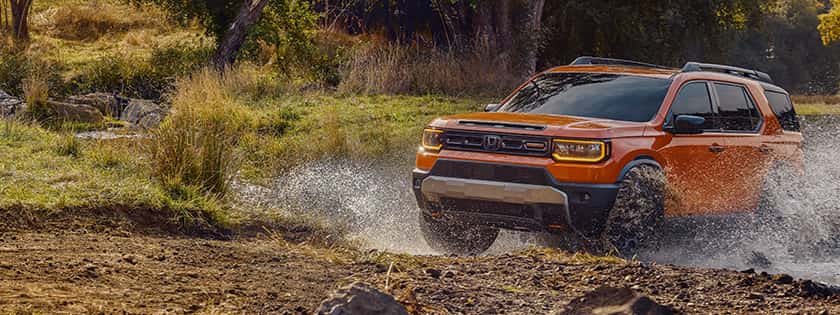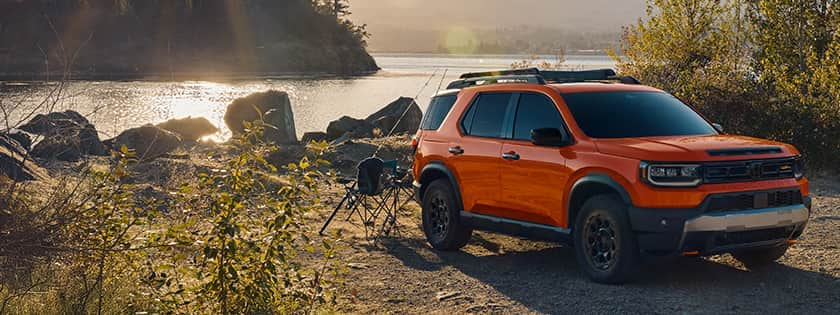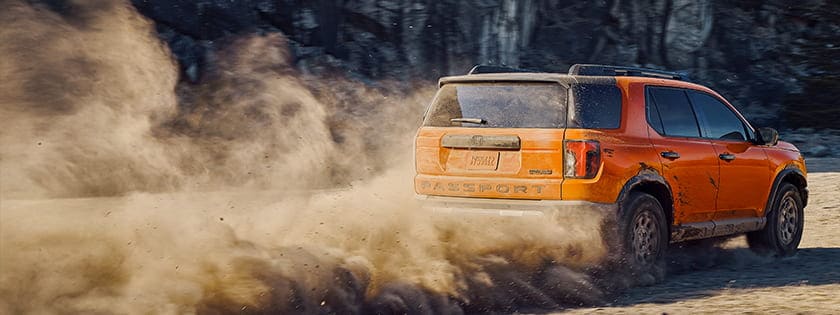Quick Summary
The 2017 Audi Q7 is a five- or seven-passenger crossover SUV. Due to its size it is considered a large SUV in the premium or luxury category. The Q7 blends a beautifully appointed cabin with a comfy-yet-sporty-enough driving experience along with a vast array of standard and optional driver-assistance systems. After languishing for years due to its age, this redesign brings the Q7 back on par with the best in the segment.
What Is It?
The 2017 Audi Q7 is a completely redesigned four-door midsize luxury SUV, the flagship of Audi's Q line of crossover vehicles. The 2017 model is the second generation of the Q7, which was first launched in 2007. Although the vehicle has been thoroughly reworked, its basic footprint remains quite similar to the original. The wheelbase is 0.5 inch shorter than the outgoing model and, at 198.8 inches long, the Q7 is 1.5 inches shorter than before. That puts it about 5 inches longer than an Acura MDX or BMW X5. The Q7 is also a half-inch narrower than before and nearly the same height. Despite the decrease in size, Audi says the new Q7 has more interior room.
The biggest news is the major weight-savings plan Audi engineers put the Q7 on. Thanks to a multi-material body that's lighter by 157 pounds, along with a lighter-weight chassis and the trimming of fat from multiple components, a U.S. Audi official told us the new car will weigh 450 to 575 pounds less than the outgoing car, depending on the configuration.
U.S. buyers will have three engines to choose from: a 2.0-liter turbocharged four-cylinder rated at 252 horsepower and 273 pound-feet of torque, a 3.0-liter supercharged V6 with 333 hp and 325 lb-ft of torque and a 3.0-liter turbodiesel V6 rated at 272 hp and 443 lb-ft of torque. All engines are mated to an eight-speed automatic transmission with steering wheel paddle shifters and Quattro all-wheel drive.
Since the new Q7 won't hit North American dealerships until January of next year, no pricing has been released yet. It's a safe bet it will increase by several hundred dollars for the 3.0 TFSI and 3.0 TDI, but the new 2.0-liter turbo could be cheaper than the outgoing 3.0T base model, which currently starts at $49,225.
What's It Like Out on the Road?
Large, luxurious, comfortable and quiet. It has the elevated driving position buyers crave without feeling completely top-heavy. U.S. cars will come standard with a nonadjustable suspension, whereas all the test vehicles we drove had the optional adaptive air suspension.
Audi did a nice job tuning the various setups because you can really feel the differences between the suspension modes. The Comfort setting is truly plush, even a bit floaty, but it glides serenely over bumps to the point you don't even feel most road imperfections. The steering effort was too light for our tastes in Comfort, but we imagine many will appreciate the plentiful assist, especially around town.
Switching to the Dynamic suspension setting brings sharper steering and improved confidence. The firmer suspension dials out the body roll. It feels sporty without going too far, meaning it still absorbs most bumps without transmitting every ripple into the cabin in the form of jitteriness or vibrations. In the Dynamic setup the Q7 feels light for its size and is plenty capable of diving into turns with aggression, with the all-wheel-drive system powering it back out with perfect traction. An Audi representative told us the standard suspension will fall in between Comfort and Dynamic in terms of its plushness, which seems about right for most people. During our brief time with the Q7, we felt we could deal with the Dynamic setting on a daily basis.
The 3.0-liter supercharged V6 proved more than adequate for the task of moving this big SUV up mountain roads, or passing cars on the flatlands with ease. Power isn't V8-like, but it's healthy, and the engine is smooth and quiet. Shifts from the transmission are supple to the point occupants barely feel a lurch, and it reacts intuitively to throttle changes without being overly shifty.
Switching to the TDI engine is a different experience. As a diesel, it doesn't rev as high, with full-throttle upshifts coming around 4,500 rpm. But with 443 lb-ft of torque, it has great midrange, which is the forte of the diesel engine. The TDI doesn't give the driver quite the excitement of the gas engine, but acceleration times are pretty similar: Audi claims the seven-seat 3.0-liter supercharged Q7 should reach 62 mph (100 km/h) in 6.3 seconds, with the TDI version doing it in 6.5.
What's the Interior Like?
It's absolutely gorgeous. It's hard not to feel pampered at all times, surrounded by taut leather, beautifully grained trim pieces, a soft Alcantara headliner and solid controls, the actions of which have nice, mechanical detents.
The new dash has a horizontally oriented design, with air vents all the way across from driver-to-passenger side. You won't be lacking for airflow. The optional 8.3-inch infotainment display screen (a 7-inch screen is standard) sits dead center and has sharp graphics.
One of the newly available features is the Audi Virtual Cockpit, a 12.3-inch instrument panel that allows you to toggle between two different screens: One has traditionally large speedometer and tachometer gauges, the other reduces gauge size but gives you a gigantic navigation map directly in front of you.
Combined with the available head-up display, it's possible to have navigation details in three different areas of the car at once. Fully optioned Q7s have so many user interface features and menu screens that it can feel overwhelming.
How Much Passenger Space Is There?
There's plenty of headroom up front, even for extra-tall folks. The seats are exceptional, with padding that's firm but thick and supportive, plus mega-adjustability and just enough lateral support to hold you in place through corners.
As with many things related to the infotainment screen, the adjustability of the seats isn't as simple as just turning one knob or pushing a button. You first turn the knob on the side of the seat, a display comes up on the screen, then you select the function you want to adjust and make the adjustment. Once you figure it out it works brilliantly, but there's that initial, "Why is nothing happening?" moment when you're turning the seat controller.
The rear seats are plenty comfortable, too. Even the middle perch is soft enough to be livable for adults, a rarity these days. The new second-row fold-forward mechanism for third-row access opens up plenty of room to get to the far back provided you have the second row slid forward first (it slides fore/aft). Operating the second-row mechanism does take some heft, though. The third-row seat is situated close to the floor in the interest of headroom, which is surprisingly good. It's livable for average-size adults. Knee and foot room are decent, too, but the seat being so low to the floor causes considerable knee bend.
What Safety Features Does It Offer?
Since the 2017 Audi Q7 won't hit the U.S. market until January of 2016 at the earliest, no crash-test results are yet available. Of course the Q7 will come with the usual features like antilock brakes, stability control and multiple airbags. Speaking of those brakes, they're suitably large: the front ventilated discs measuring 14.8 inches with six-piston fixed calipers, with 13.8-inch rear rotors with single-piston sliding calipers. They felt strong and secure during our twisty mountain road driving, without feeling touchy during the around-town stuff.
Driver-assistance systems are becoming more and more common these days, and Audi is at the lead here, claiming the new Q7 "currently offers the widest selection of driver-assistance systems on the world market." There's no question there's a boatload of standard and available features. These range from the more commonplace adaptive cruise control, Active Lane Assist, Audi Pre Sense Basic (if it detects an unstable driving condition, it tightens belts, closes windows and sunroof, activates hazard lights) and Audi Pre Sense City (observes the road ahead for vehicles and pedestrians, will initiate full deceleration if needed when traveling below 53 mph).
There's also Attention Assist (analyzes driver behavior to detect if they're losing concentration), Traffic Jam Assist (can take over steering in slow-moving traffic, in conjunction with adaptive cruise), a Predictive Efficiency Assistant (uses route data to adjust speed for curves, speed limits and other cars in conjunction with adaptive cruise), Exit Assist (warns you if you're about to open any of the four doors into a cyclist or another car), Collision Avoidance Assist and Turn Assist. This last system monitors oncoming traffic when making a left turn at low speeds, and if it senses a potential collision with an oncoming car will bring the Q7 to an instant and full halt. There's also a lane-change assistant as well as Cross Traffic Assist Rear, which detects vehicles when you're backing out of a parking space.
What Kind of Mileage Does It Deliver?
Thanks to the Q7's massive weight-reduction diet and more efficient engines, you can expect significantly improved fuel economy for both the 3.0-liter supercharged V6 and the 3.0-liter turbodiesel V6.
Official EPA ratings are still a ways off, and Audi declined to give early estimates for the U.S. market, but phrases like "class-leading numbers" and "the engines consume significantly less fuel than the previous model" were bandied about.
What Are Its Closest Competitors?
The Acura MDX offers strong value thanks to reasonable pricing, a fuel-efficient V6 and excellent interior room. Although handling is decent and the cabin is well-built, it doesn't feel as luxurious as the Q7.
The BMW X5 gives the most driver-engagement in the segment, plus there's a choice of a turbo inline-six, a diesel or a turbo V8. The third-row seat is cramped and it's on the expensive side.
The Cadillac Escalade serves as an alternative choice. As an old-school body-on-frame SUV, it sits higher and doesn't handle with the aplomb of its European and Japanese counterparts. Its naturally aspirated V8 is smooth and powerful, if thirsty, and the interior is comfortable and laden with luxury.
If you're at all serious about off-roading, the Land Rover LR4 is a great choice. It also has a surprisingly adult-friendly third row and good cargo room, but its engine is a bit of a gas hog.
Why Should You Consider This Car?
Luxury and prestige are important to you, but you prefer to be efficient as well. And you want the latest driver-assistance systems along with high-tech infotainment and available top-shelf 3D audio systems. Off-roading isn't of high importance, on-road fun is, and you require a usable third-row.
Why Should You Think Twice About This Car?
If the grunt of a V8 is important, look elsewhere in the segment. Same goes if you want true off-road capability. The new MMI user interface can get overwhelming as well so if you prefer old-school simplicity the Q7 might not feel quite right.
| Vehicle | |
|---|---|
| Year Make Model | 2017 Audi Q7 3.0 TSFI quattro 4dr SUV AWD (3.0L 6cyl S/C 8A) |
| Vehicle Type | AWD 4dr 7-passenger SUV |
| Estimated MSRP | $50,000-$67,000 (full model range) |
| Assembly location | Bratislava, Slovakia |
| Drivetrain | |
|---|---|
| Configuration | Longitudinal, front-engine, all-wheel drive |
| Engine type | Supercharged, direct-injected V-6, gasoline with auto-stop/start |
| Displacement (cc/cu-in) | 2,995/183 |
| Block/head material | Aluminum/aluminum |
| Valvetrain | DOHC, 4 valves/cylinder variable intake + exhaust-valve timing |
| Compression ratio (x:1) | 10.8 |
| Horsepower (hp @ rpm) | 333 @ 5,500 |
| Torque (lb-ft @ rpm) | 325 @ 2,900 |
| Fuel type | Premium unleaded (required) |
| Transmission type | 8-speed automatic with console shifter and steering-mounted paddles with sport and manual modes |
| Transmission ratios (x:1) | I = 4.714; II = 3.143; III = 2.106; IV = 1.667; V = 1.285; VI = 1.000; VII = 0.839; VIII = 0.667; R = 3.317 |
| Final-drive ratio (x:1) | 3.204 |
| Chassis | |
|---|---|
| Suspension, front | Independent multilink, self-leveling pneumatic springs, driver-adjustable multi-mode variable dampers, stabilizer bar |
| Suspension, rear | Independent multilink, self-leveling pneumatic springs, driver-adjustable multi-mode variable dampers, stabilizer bar |
| Steering type | Electric-over-hydraulic-assist, speed-proportional, rack-and-pinion power steering with active rear-steer |
| Steering ratio (x:1) | 15.8 |
| Tire make and model | Pirelli Scorpion Verde |
| Tire type | All-season front and rear |
| Tire size | 285/45R20 (112Y) |
| Wheel size | 20-by-9 inches front and rear |
| Wheel material | Alloy |
| Brakes, front | 14.8-inch ventilated discs with six-piston fixed calipers |
| Brakes, rear | 13.8-inch ventilated discs with single-piston sliding calipers |
| Track Test Results | |
|---|---|
| 0-60 mph, mfr. claim (sec.) | 6.3 (0-62 mph/100 km/h) |
| Fuel Consumption | |
|---|---|
| Fuel tank capacity (U.S. gal.) | 22.5 |
| Audio and Advanced Technology | |
|---|---|
| Stereo description | Optional Bang & Olufsen 3D audio system with 23 speakers and 1,920 watts |
| iPod/digital media compatibility | Standard iPod via twin USB jacks and aux-in jack |
| Satellite radio | Standard Sirius XM |
| Rear seat video and entertainment | Optional via twin Audi tablets |
| Bluetooth phone connectivity | Standard |
| Navigation system | Optional, hard-drive |
| Smart entry/Start | Optional ignition and doors |
| Parking aids | Standard rear parking sonar, optional back-up camera, automated self-parking system and rear cross-traffic detection |
| Blind-spot detection | Optional |
| Adaptive cruise control | Optional |
| Lane-departure monitoring | Optional |
| Collision warning/avoidance | Standard |
| Night Vision | Optional |
| Dimensions & Capacities | |
|---|---|
| Curb weight, mfr. claim (lbs.) | 4,475 (7-seater) |
| Length (in.) | 198.8 |
| Width (in.) | 77.6 |
| Height (in.) | 68.5 |
| Wheelbase (in.) | 117.7 |
| Track, front (in.) | 66.1 |
| Track, rear (in.) | 66.6 |
| Seating capacity | 7 |
| Warranty | |
|---|---|
| Bumper-to-bumper | 4 years/50,000 miles |
| Powertrain | 4 years/50,000 miles |
| Corrosion | 12 years |
| Roadside assistance | 4 years |
| Free scheduled maintenance | 1 year/5,000 miles |
The manufacturer provided Edmunds this vehicle for the purposes of evaluation.




